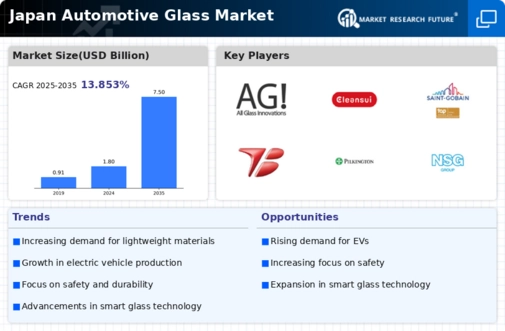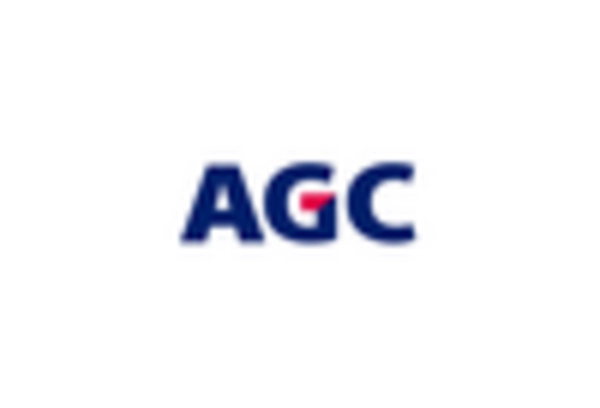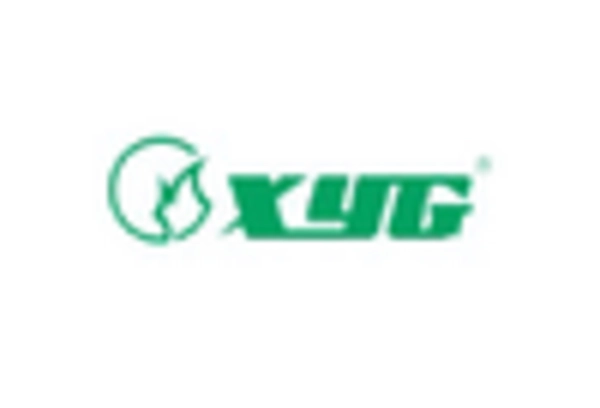Rising Vehicle Production
The automotive glass market in Japan is experiencing growth due to the increasing production of vehicles. In recent years, Japan has maintained its position as one of the leading automobile manufacturers, with production figures reaching approximately 8 million units annually. This surge in vehicle production directly correlates with the demand for automotive glass, as each vehicle requires multiple glass components, including windshields, side windows, and rear windows. The automotive glass market is likely to benefit from this trend, as manufacturers strive to meet the rising demand for high-quality glass products. Furthermore, the introduction of new vehicle models and the expansion of electric vehicle production are expected to further drive the need for advanced glass solutions, enhancing the overall market landscape.
Growth of Electric Vehicles
The rise of electric vehicles (EVs) in Japan is significantly impacting the automotive glass market. As the country aims to reduce carbon emissions and promote sustainable transportation, the adoption of EVs is expected to increase. This shift presents opportunities for the automotive glass market, as EVs often require specialized glass solutions to enhance energy efficiency and reduce weight. For instance, lightweight glass can contribute to improved battery performance and overall vehicle range. The automotive glass market is likely to see a surge in demand for innovative glass products tailored for electric vehicles, as manufacturers strive to meet the evolving needs of the automotive sector.
Consumer Preference for Advanced Features
In Japan, consumer preferences are shifting towards vehicles equipped with advanced features, which is positively impacting the automotive glass market. Features such as heads-up displays, solar control glass, and acoustic glass are becoming increasingly popular among consumers. This trend indicates a growing demand for specialized glass products that enhance vehicle performance and comfort. The automotive glass market is adapting to these preferences by innovating and developing new glass technologies that cater to the needs of modern consumers. As a result, manufacturers are investing in research and development to create products that not only meet safety standards but also provide additional functionalities, thereby potentially increasing their market share.
Government Initiatives for Vehicle Safety
The Japanese government has implemented various initiatives aimed at enhancing vehicle safety, which in turn influences the automotive glass market. Regulations mandating the use of high-strength glass in vehicles are becoming more prevalent, as authorities seek to reduce accidents and improve passenger safety. The automotive glass market is responding to these regulations by developing stronger, more durable glass products that comply with safety standards. This focus on safety is likely to drive innovation within the market, as manufacturers explore new materials and technologies to produce glass that can withstand impact and provide better protection for occupants. Consequently, the market may see an increase in demand for safety-oriented glass solutions.
Technological Integration in Manufacturing
The automotive glass market in Japan is witnessing a transformation due to the integration of advanced manufacturing technologies. Automation and smart manufacturing processes are being adopted by glass manufacturers to enhance production efficiency and product quality. This trend suggests that the automotive glass market is moving towards more sophisticated production techniques, which may lead to reduced costs and improved turnaround times. Additionally, the use of data analytics and IoT in manufacturing processes allows for better quality control and inventory management. As manufacturers embrace these technologies, the automotive glass market is likely to benefit from increased competitiveness and the ability to respond swiftly to market demands.

















Leave a Comment